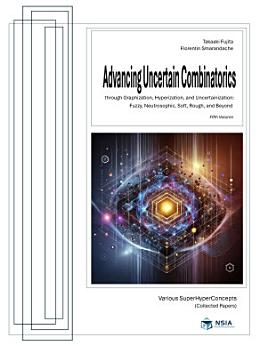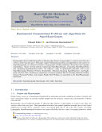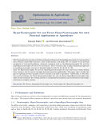Advancing Uncertain Combinatorics through Graphization, Hyperization, and Uncertainization: Fuzzy, Neutrosophic, Soft, Rough, and Beyond: Fifth volume: Various SuperHyperConcepts (Collected Papers)
Giới thiệu về sách điện tử này
The series aims to explore the ongoing evolution of uncertain combinatorics through innovative methodologies such as graphization, hyperization, and uncertainization. These approaches integrate and extend core concepts from fuzzy, neutrosophic, soft, and rough set theories, providing robust frameworks to model and analyze the inherent complexity of real-world uncertainties.
At the heart of this series lies combinatorics and set theory—cornerstones of mathematics that address the study of counting, arrangements, and the relationships between collections under defined rules. Traditionally, combinatorics has excelled in solving problems involving uncertainty, while advancements in set theory have expanded its scope to include powerful constructs like fuzzy and neutrosophic sets. These advanced sets bring new dimensions to uncertainty modeling by capturing not just binary truth but also indeterminacy and falsity.
In this fifth volume, the exploration of Various SuperHyperConcepts provides an innovative lens to address uncertainty, complexity, and hierarchical relationships. It synthesizes key methodologies introduced in earlier volumes, such as hyperization and neutrosophic extensions, while advancing new theories and applications. From pioneering hyperstructures to applications in advanced decision-making, language modeling, and neural networks, this book represents a significant leap forward in uncertain combinatorics and its practical implications across disciplines.
The book is structured into 17 chapters, each contributing unique perspectives and advancements in the realm of Various SuperHyperConcepts and their related frameworks:
Chapter 1 introduces the concept of Body-Mind-Soul-Spirit Fluidity within psychology and phenomenology, while examining established social science frameworks like PDCA and DMAIC. It extends these frameworks using Neutrosophic Sets, a flexible extension of Fuzzy Sets, to improve their adaptability for mathematical and programming applications. The chapter emphasizes the potential of Neutrosophic theory to address multi-dimensional challenges in social sciences.
Chapter 2 delves into the theoretical foundation of Hyperfunctions and their generalizations, such as Hyperrandomness and Hyperdecision-Making. It explores higher-order frameworks like Weak Hyperstructures, Hypergraphs, and Cognitive Hypermaps, aiming to establish their versatility in addressing multi-layered problems and setting a foundation for further studies.
Chapter 3 extends traditional decision-making methodologies into HyperDecision-Making and n-SuperHyperDecision-Making. By building on approaches like MCDM and TOPSIS, this chapter develops frameworks capable of addressing complex decision-making scenarios, emphasizing their applicability in dynamic, multi-objective contexts.
Chapter 4 explores integrating uncertainty frameworks, including Fuzzy, Neutrosophic, and Plithogenic Sets, into Large Language Models (LLMs). It proposes innovative models like Large Uncertain Language Models and Natural Uncertain Language Processing, integrating hierarchical and generalized structures to advance the handling of uncertainty in linguistic representation and processing.
Chapter 5 introduces the Natural n-Superhyper Plithogenic Language by synthesizing natural language, plithogenic frameworks, and superhyperstructures. This innovative construct seeks to address challenges in advanced linguistic and structural modeling, blending attributes of uncertainty, complexity, and hierarchical abstraction.
Chapter 6 defines mathematical extensions such as NeutroHyperstructures and AntiHyperstructures using the Neutrosophic Triplet framework. It formalizes structures like neutro-superhyperstructures, advancing classical frameworks into higher-dimensional realms.
Chapter 7 explores the extension of Binary Code, Gray Code, and Floorplans through hyperstructures and superhyperstructures. It highlights their iterative and hierarchical applications, demonstrating their adaptability for complex data encoding and geometric arrangement challenges.
Chapter 8 investigates the Neutrosophic TwoFold SuperhyperAlgebra, combining classical algebraic operations with neutrosophic components. This chapter expands upon existing algebraic structures like Hyperalgebra and AntiAlgebra, exploring hybrid frameworks for advanced mathematical modeling.
Chapter 9 introduces Hyper Z-Numbers and SuperHyper Z-Numbers by extending the traditional Z-Number framework with hyperstructures. These extensions aim to represent uncertain information in more complex and multidimensional contexts.
Chapter 10 revisits category theory through the lens of hypercategories and superhypercategories. By incorporating hierarchical and iterative abstractions, this chapter extends the foundational principles of category theory to more complex and layered structures.
Chapter 11 formalizes the concept of n-SuperHyperBranch-width and its theoretical properties. By extending hypergraphs into superhypergraphs, the chapter explores recursive structures and their potential for representing intricate hierarchical relationships.
Chapter 12 examines superhyperstructures of partitions, integrals, and spaces, proposing a framework for advancing mathematical abstraction. It highlights the potential applications of these generalizations in addressing hierarchical and multi-layered problems.
Chapter 13 revisits Rough, HyperRough, and SuperHyperRough Sets, introducing new concepts like Tree-HyperRough Sets. The chapter connects these frameworks to advanced approaches for modeling uncertainty and complex relationships.
Chapter 14 explores Plithogenic SuperHyperStructures and their applications in decision-making, control, and neuro systems. By integrating these advanced frameworks, the chapter proposes innovative directions for extending existing systems to handle multi-attribute and contradictory properties.
Chapter 15 focuses on superhypergraphs, expanding hypergraph concepts to model complex structural types like arboreal and molecular superhypergraphs. It introduces Generalized n-th Powersets as a unifying framework for broader mathematical applications, while also touching on hyperlanguage processing.
Chapter 16 defines NeutroHypergeometry and AntiHypergeometry as extensions of classical geometric structures. Using the Geometric Neutrosophic Triplet, the chapter demonstrates the flexibility of these frameworks in representing multi-dimensional and uncertain relationships.
Chapter 17 establishes the theoretical groundwork for SuperHyperGraph Neural Networks and Plithogenic Graph Neural Networks. By integrating advanced graph structures, this chapter opens pathways for applying neural networks to more intricate and uncertain data representations.









